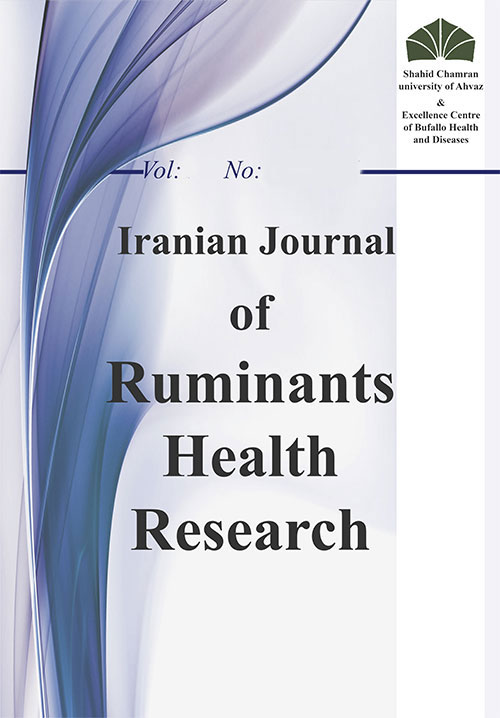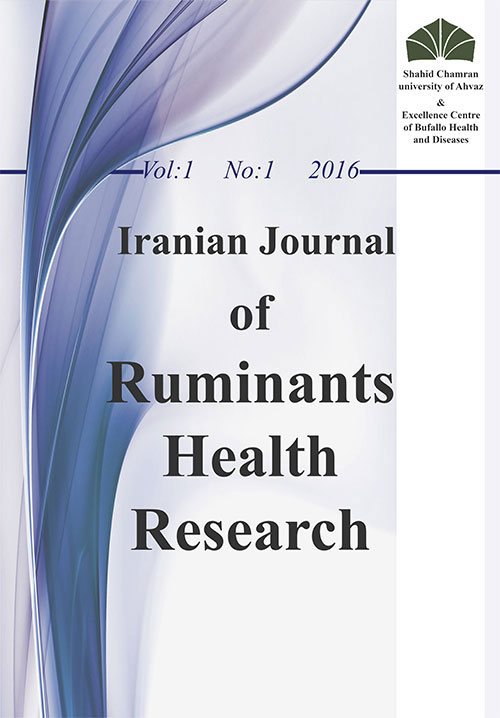فهرست مطالب

Journal of Ruminants Health Research
Volume:1 Issue: 2, Summer and Autumn 2016
- تاریخ انتشار: 1395/04/07
- تعداد عناوین: 7
-
-
Pages 1-8At calving time, the cows were monitored and blood samples were taken from jugular vein of 38 cows with parturient paresis and 38 healthy ones. The levels of calcium, phosphorus, magnesium, sodium, potassium, chloride, glucose, triglyceride, cholesterol, albumin, globulin and A/G ratio were assessed to find the correlation between the degree of hypocalcemia and other parameters. According to calcium concentration of milk fever cows (downers), five subgroups (); 5.1-6 as b); 6.1-7 as c); 7.1- 8 as d) and 8.1Keywords: Parturient paresis, Milk fever, Parturient hypocalcemia, Hypophosphatemia, Dairy cattle
-
Pages 9-16The role of stress in the pathogenesis of ovarian cysts is believed to be mediated by the discharge of endogenous cortisol, which inhibits LH release. Endogenous opioid peptides are involved in many responses to stress. Therefore, the aim of this study was to determine the effect of epidural administration of Naloxone (NX) on cystic regression and follicle development leading to normal oestrus in dairy cattle.This study was conducted on 91 dairy cattle affected by follicular cysts, divided randomly into 3 groups.Group1 (n=30) cows were treated epidurally (lumbo-sacral) with 0.8 mg Naloxan hydrochloride (NX). Group2 (n=30) cows were treated epidurally with GnRH analogue (100 mcg gondorelin acetate). Group3 (n=31) cows were considered as control and received 5 ml normal saline epidurally.Although the results of this study showed that Naloxane was better than the other two groups to treat follicular cysts, there was no significant difference in differnnt criteria, such as CL formation, increasing plasma P4 concentrations and 1st service conception rates among 3 groups.Keywords: Cow, Follicular cyst, Naloxane
-
Pages 17-24Meat inspection records in abattoirs located in Torbat-e-heidarieh (northeast Iran), from 18 May 2009 to 30 May 2015, were used to determine the prevalence of liver fluke diseases in sheep and cattle in the region. A total of 1004858 livestock including 867015 sheep and 137843 cattle were slaughtered in the 6-year period. Dicrocoeliosis, fasciolosis and hydatidosis were responsible for 2%, 1.92% and 7.97% of total liver condemnations, respectively. Total condemnation of liver caused by hydatidosis in different animals was by far more than that observed in fasciolosis and dicrocoeliosis. The prevalence of liver condemnations due to hydatidosis increased from 4.23% and 5.21% in 2009 to 11.08% and 9.54% in 2015 for sheep and cattle, respectively. Dicrocoeliosis and fasciolosis were less prevalent than hydatidosis, and the prevalence rate of dicrocoeliosis declined from 1.87% and 2.35% in 2009 to 1.11% and 0.64% in 2015 for sheep and cattle, respectivel; however, the prevalence rate of fasciolosis increased from 0.7% in 2009 to 3.3% in 2015 for sheep and declined from 2.12% in 2009 to 1.45% in 2015 for cattle. Data revealed significant seasonal pattern for dicrocoelium dendriticum in sheep (p=0.045), but, in the case of Fasciola spp. and hydatid in various animals, there have been no significant differences regarding the season. Because of hydatidosis, fasciolosis and dicrocoeliosis, liver condemnations were more common in cattle slaughtered throughout fall, while these were larger in winter for sheep. This study offers baseline information for the future tracking of these possibly essential parasitic attacks in the region.Keywords: Prevalence, Fasciolosis, Dicrocoeliosis, Hydatosis, Torbat-e-heidarieh, Iran
-
Pages 25-34An easy way to evaluate the cardiovascular system is recording the cardiac electrical activities. Reviewing the available literatures suggests that buffalos ECG compared to other large animals have been neglected and the carried out studies in this field are too limited. Using this method for the diagnosis of cardiac disorders needs the standardization, not only among animal species but also among different breeds of a species. The present study was performed to determine the normal parameters of electrocardiogram in 100 clinically healthy buffaloes of different ages and sexes. The buffaloes were divided into male and female and two age groups (less than 2.5, and more than 2.5 yrs.) on the base of dental formula. After taking the anamnesis and performing a clinical examination, electrocardiogram was obtained based on base - apex lead system with the paper speed of 25mm sec-1 and sensitivity of 10 mm mV-1 at rest. Results showed that regardless of age and sex, the median and interquartile range of P, R, S and T wave's amplitude (voltage) was, 0.18±0.04, 0.69±0.40, 0. 97± 0.31 and 0.20 ±0.25 mV, respectively and the duration of p wave, QRS complex, and T wave was determined 0.06 ±0.01, 0.06 ±0.01 and 0.08 ± 0.02 seconds, respectively. Only in a less than 2.5 years old female buffalo, Q wave was recorded, the amplitude of this wave was 0.07 mV. Statistical method showed that among different ECG parameters, there was significant difference between the two sexes (pKeywords: Electrocardiogram, Buffalo, Parameter, Khuzestan
-
Pages 35-73Rabies is one of the infectious diseases, highly fatal and true zoonoses. The disease occurs in most countries. In Iran, rabies is endemic and a major public health Problem. The most warm- blooded animals are susceptible to rabies. The methods of transmission is almost always by the bite of an infected animal to human and animals. The saliva of rabid animal contains the rabies virus. The main source animals are dog, wolf, wild carnivores and fox. Today, there are three hundred anti rabies treatment centers in Iran for Post- exposure treatment. During the year 2004, 113542 Persons have been treated in anti rabies Post- exposure centers. According to Pasteur institute of Iran, 418 Positive cases of animal rabies and 3 cases of human rabies in 2001, 350 positive cases of animal and 6 cases of human in 2002, 309 positive cases of animal and 10 cases of human in 2003, and 320 positive cases of animal and 5 cases of human rabies in 2004 have been confirmed in all parts of country. Due to the increasing trend of animal bite and positive cases of animal and human, it is important that the responsible authorities of the government do effective control measures in rabies combat.Keywords: Rabies, Iran, Animal, Human
-
Pages 38-48In this study, the relationships and correlations between milk production and some blood metabolites related to energy and protein balance and their effects were investigated on returning to estrus after AI in lactating Holstein dairy cows. Blood and milk samples were collected from sixty lactating Holstein dairy cows based on their reproductive status in 13-17 d post AI. BUN, MUN, glucose, triglyceride, cholesterol and BHBA were measured by enzymatic colorimetric method and blood progesterone concentration was measured by ELISA method. Between 18-25 d post AI, 27 cows returned to estrus (RE group), but 33 cows did not (NRE group). In RE group, there were significant correlations between DIM and Monthly Milk yield Record (MMR) (pKeywords: Blood metabolites, Milk production, Physiological imbalance, reproduction
-
Pages 49-61Diuretics have several therapeutic advantages in dairy cows but there are different side effects such as acid-base and electrolyte imbalances which may affect the electrocardiographic parameters. Fifteen multiparous, clinically healthy, non-pregnant and high producing 4-year-old Holstein dairy cows at their early lactation period were randomly divided into 3 equal experimental groups. Furosemide was infused intravenously at 3 different doses containing group 1: 2.5 mg/kg; group 2: 5 mg/kg and group 3: 10 mg/kg. Electrocardiogram recordings and blood samplings were performed at prior and 1, 2, 3, 4, 5 and 24 hours after furosemide administrations. Sera after separation were assayed for sodium, potassium, chloride, calcium, magnesium and phosphorus concentrations. There were no significant changing patterns in P, R, S and T amplitudes. P-R, R-R, Q-T and S-T intervals increased significantly after furosemide administrations in groups 2 and 3. Electrocardiographic intervals in groups 3 were higher than other groups (PKeywords: Furosemide, Electrocardiogram, Electrolyte imbalance, Holstein dairy cow


